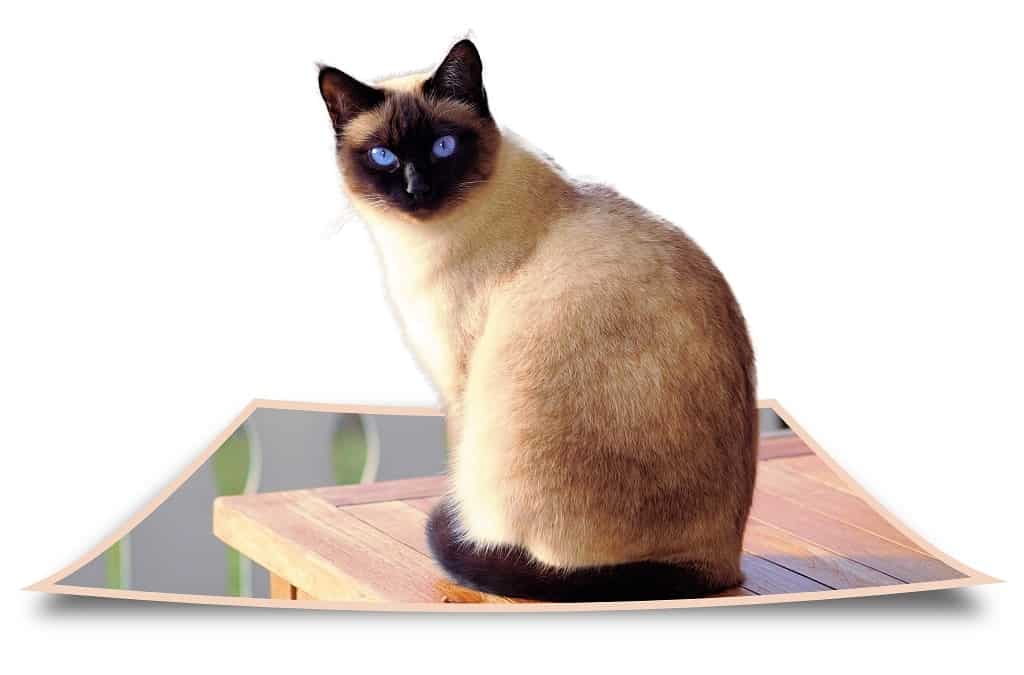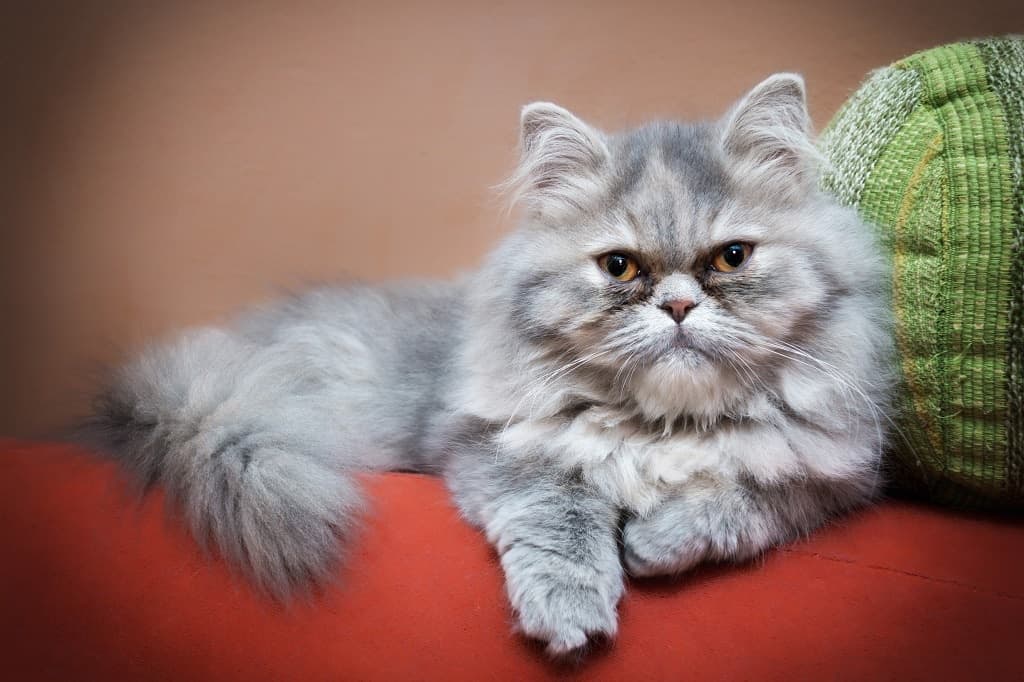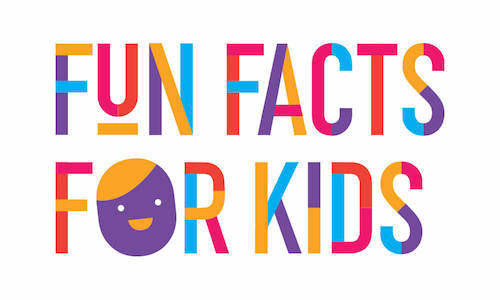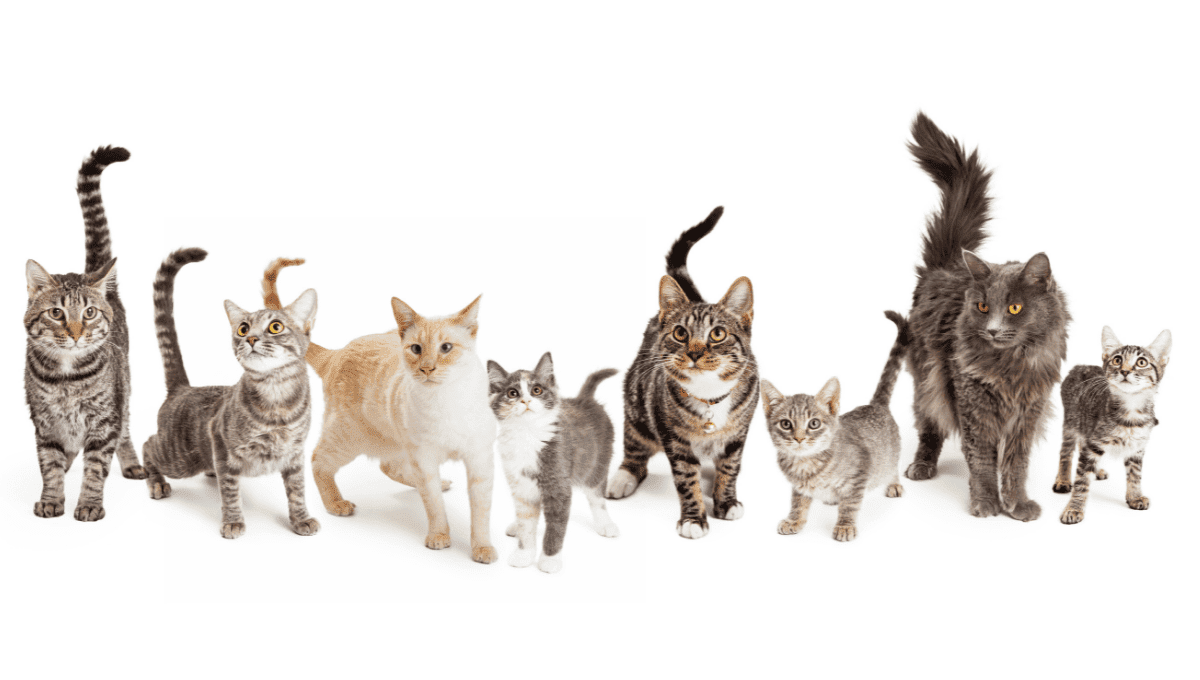If you are looking for facts about cats to learn more about these gorgeous furry friends, then you are in the right place. In this article you will find all the best, most detailed facts about cats for your school project, for a homework assignment or just for fun! Let’s dive in!
What are cats?
Cats are a species of small, domesticated mammals. They are considered beloved pets in many regions of the world, however they can also be found in the wild. Their binomial name is Felis Catus.
Felines have strong flexible bodies, quick reflexes, sharp teeth, and retractable claws. They can jump up to six times their length. Cats have an advanced sense of smell and hearing, and they are able to rotate their ears 180 degrees. Despite being near-sighted, they have a much better peripheral and night vision than humans do.
Cats have 18 toes: five on each front paw, and four on each back paw. When cats are born with more toes than 18, they likely have a condition called polydactylism. Their whiskers are really important in allowing them to detect and respond to changes in their environment. Additionally, cats also have a set of whiskers on the back of their front legs.
We love these books about cats for kids!
What do cats eat?
Cats are carnivores, which means that they require a meat-based diet. They need the protein from meat in order to maintain their health and survive. In the wild, cats feast on the raw meat, bones, and organs from their prey. A house cat’s dietary requirements will change based on its age and health. They are believed to be the only mammal that is unable to taste sweetness. If a cat suddenly refuses to eat, this a clear sign of illness and it must be taken to the vet.
Kitten facts
A kitten is a newborn cat. Kittens become adult cats by the time they turn one year old. They are all born with whiskers as long as their body is wide, 26 baby teeth, and striking blue eyes. They are unable to regulate their body temperature or even go to the bathroom alone. The mama cat knows this and knows how to take care of them adequately. Kittens are usually unable to walk until they are three weeks old, which is when they open their eyes.
A kitten litter is the birth of multiple offspring from one mama cat. The average litter size is up to nine kittens; however, the largest recorded size was 19. Kittens of the same litter don’t always have the same dad, which could explain why they rarely look related. Kittens sweat from their paws.
Household items that are harmful to cats
Cats are sensitive to many chemicals and drugs as they have fewer certain liver enzymes, affecting their liver metabolism. They’re also excellent at hiding their symptoms when ill.
Below is a list of common household items that are the most toxic to cats:
- Lilies
- Chocolate
- Vitamin D3
- Human foods such as garlic, onions, chives, leeks (Allium foods)
- Insectidies and human medications
- Household cleaners
- Glowsticks
Cats’ life expectancy and health

The average life expectancy for a house cat now is 15 years. However, just 40 years ago, it was only seven years during the 80’s. It has been found that neutering a cat can increase it’s life expectancy by double for males, and 62% for females. There have been about 250 heritable genetic disorders found that can threaten a cat’s life expectancy. However, veterinary science has come a long way, and preventative measures, testing, and treatment is now possible for a lot more diseases.
Cats in history and mythology
Cats have been companions to humans for approximately 10,000 years. They are featured in many historical and mythological stories across different cultures. Here are some fun facts:
- Cats were worshipped in Ancient Egypt. The goddess Bastet took the war-like aspect of a lioness and was often portrayed in cat form.
- Herodotus, a famous Greek historian, reported that the entire family shaved their eyebrows in mourning and held a burying ritual when a household cat died.
- The earliest evidence of Greeks having household cats as companions was identified through two coins. On the coins, the famous founders of Rhegion and Taras were depicted playing with their cats.
- In Japan, the maneki neko cat is a symbol for good fortune.
- In Norse Mythology, Freyja, the Goddess of Love, is told to have ridden a chariot pulled by two grey cats. Farmers who wished protection for their crops left pans of milk for them.
- The ancient Greek word for cat was ailouros, which means ‘thing with the waving tail’
- In Europe, cats were seen as good luck charms by actors, and often helped cure stage fright.
Cat body language

Cats, like humans, reveal a lot about themselves through their body language. Below are some common domesticated cat behaviours, and what they mean.
Purring is often associated with pleasant social situations; however, it is a self-soothing behaviour. Purring is a way to release endorphins for cats.
Teeth chattering may happen when cats look outside. This means that your cat is frustrated and slightly aggravated. Specialists also said this is the cat’s natural instinct to get ready for hunting prey. However, this behaviour is completely normal.
Head bumping is when the cat rubs their head against you. Whilst many consider this an act of affection, this is actually the cat’s way of showing ownership over you. Behaviourists call this act ‘bunting’.
Kneading, or ‘making biscuits’, is when a cat presses it’s paws into their owner, massaging back and forth. This instinct dates back to their early nursing days, as kittens pressing on their mama cat’s glands encouraged milk production. This shows that they are happy and content.
Zoomies are a house cats way of releasing built up energy, resulting in them barrelling down hallways during odd hours.
Ear twitching back and forth is a clear sign that your cat is anxious and agitated.
Tail twitching is when the tip of a cat’s tail slightly twitches. It usually indicates that they may be excited or focused.
Bushy tails signify that a cat is getting defensive and angry. They make their tails and back fluffier in order to appear bigger and scare off predators.
Famous cats
Below are some of the most famous and well-known cats in the world. This list includes both fictional and real cats.
Creme Puff
Creme Puff was the oldest cat alive, living from August 1967 to August 2005. She was 38 years and 3 days old when she unfortunately passed away. She spent her life in Austin, Texas, alongside her owner Jake Perry.
Grumpy Cat
Tardar Sauce, most commonly known as Grumpy Cat, became viral after a post of her garnered massive media attention on Reddit in 2012. She gained popularity for having a very grumpy face. Her owners confirmed that she was in fact a very happy cat, with a type of dwarfism. Her breed is a mix of Calico Short Hair and a Grey Tabby.
Hello Kitty
Hello Kitty is a fictional cat created by Yuko Shimizu and owned by the Japanese company Sanrio. Her full name is Kitty White, and she is featured in a cartoon with her family. She is a personification of a Japanese Bobtail cat, best known for her white fur and pink bow. Hello Kitty received widespread international commercial success by both teenage and adult consumers. As of now, there are over 50,000 different Hello Kitty products and merchandise in over 130 countries.
If you want to get your own Hello Kitty products – click here.
Nala
Nala holds the Guiness World Record for the most followers for a cat on Instagram. Easily recognisable by her striking blue eyes and cartoon-like face, the Siamese/Tabby has reached over 4 million followers. She also has her own merchandise.
Garfield
Garfield is a fictional orange cat best known for his love of lasagne and sleeping. He is the protagonist of the comic strips created by Jim Davis. Garfield is a Persian Tabby. He is featured alongside his owner, Jon Arbuckle, and dog, Odie, as well as many other beloved characters. The comic has since been made into a TV show and has gained massive popularity.
Orangey
The cat from Breakfast at Tiffany’s, Orangey, won the Patsy award twice for being a skilled actor. However, his work ethic is questionable at best. He is known for biting and scratching his human co-stars and running away from set when he didn’t feel like acting. Filming had to be postponed until he was found again. This ginger cat also starred in various other TV shows and films, including The Diary of Anne Frank, The Dick van Dyke Show, and The Beverly Hillbillies.
Mrs Norris
Mrs Norris, the cat from the Harry Potter series, is one of the best-known cats in movies. This role was played by four different Maine Coons: Alanis, Pebbles, Maximus, and Cornilus. These four cats were each trained on a different skill. Alanis was best at holding still, so she was used in most holding scenes. Pebbles was trained to walk and stop at certain spots, so he acted the hallway scenes. Maximus was best trained at jumping, so he jumped on Mr Filch’s shoulder. Cornilus could look in certain directions on command.
Fun facts about cats for kids
After reading this “Fun facts for kids about cats” article, I hope you’ll agree that these furry creatures make adorable pets. They have accompanied humans for thousands of years, making their present known in multiple cultures across the globe. Cats and kittens are loved by both adults and children alike.
If you would like some stickers to embellish your school project about cats, click here.
Discover more of our fun facts for kids animal guides below.
- Quokka Facts for Kids
- Ant Facts for Kids
- Crocodile Facts for Kids
- Dolphin Facts for Kids
- Echidna Facts for Kids
- Bee Facts for Kids
- Australia’s Deadliest Animals Facts for Kids
- Cheetah Facts for Kids
- Endangered Animals Facts for Kids
- Kangaroo Facts for Kids
- Possum Facts for Kids
- Koala Facts for Kids
- Dog Facts for Kids
- Butterflies Facts for Kids
- Dingo Facts for Kids
- Turtle Facts for Kids
- Penguin Facts for Kids
- Whale Facts for Kids
- Wolf Facts for Kids
- Sustainability Facts for Kids

